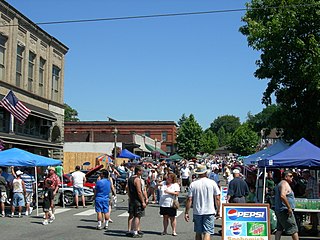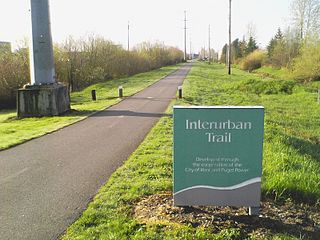Related Research Articles

Snohomish County is a county located in the U.S. state of Washington. With a population of 827,957 as of the 2020 census, it is the third-most populous county in Washington, after nearby King and Pierce counties, and the 73rd-most populous in the United States. The county seat and largest city is Everett. The county forms part of the Seattle metropolitan area, which also includes King and Pierce counties to the south.

Arlington is a city in northern Snohomish County, Washington, United States, part of the Seattle metropolitan area. The city lies on the Stillaguamish River in the western foothills of the Cascade Range, adjacent to the city of Marysville. It is approximately 10 miles (16 km) north of Everett, the county seat, and 40 miles (64 km) north of Seattle, the state's largest city. As of the 2020 U.S. census, Arlington had a population of 19,868; its estimated population is 20,075 as of 2021.

Edmonds is a city in Snohomish County, Washington, United States. It is located in the southwest corner of the county, facing Puget Sound and the Olympic Mountains to the west. The city is part of the Seattle metropolitan area and is located 15 miles (24 km) north of Seattle and 18 miles (29 km) southwest of Everett. With a population of 42,853 residents in the 2020 U.S. census, Edmonds is the third most populous city in the county.

Lynnwood is a city in Snohomish County, Washington, United States. The city is part of the Seattle metropolitan area and is located 16 miles (26 km) north of Seattle and 13 miles (21 km) south of Everett, near the junction of Interstate 5 and Interstate 405. It is the fourth-largest city in Snohomish County, with a population of 38,568 in the 2020 U.S. census.

Marysville is a city in Snohomish County, Washington, United States, part of the Seattle metropolitan area. The city is located 35 miles (56 km) north of Seattle, adjacent to Everett on the north side of the Snohomish River delta. It is the second-largest city in Snohomish County after Everett, with a population of 70,714 at the time of the 2020 U.S. census. As of 2015, Marysville was also the fastest-growing city in Washington state, growing at an annual rate of 2.5 percent.

Mountlake Terrace is a suburban city in Snohomish County, Washington, United States. It lies on the southern border of the county, adjacent to Shoreline and Lynnwood, and is 13 miles (21 km) north of Seattle. The city had a population of 19,909 people counted in the 2010 census.

Snohomish is a city in Snohomish County, Washington, United States. The population was 9,098 at the 2010 census. It is located on the Snohomish River, southeast of Everett and northwest of Monroe. Snohomish lies at the intersection of U.S. Route 2 and State Route 9. The city's airport, Harvey Airfield, is located south of downtown and used primarily for general aviation.

Fremont is a neighborhood in Seattle, Washington, United States. Originally a separate city, it was annexed to Seattle in 1891. It is named after Fremont, Nebraska, the hometown of two of its founders: Luther H. Griffith and Edward Blewett.

The Fremont Troll is a public sculpture in the Fremont neighborhood of Seattle, Washington in the United States.

Julius Pierpont "J. P." Patches was a clown and the main character on The J. P. Patches Show, an Emmy Award-winning local children's television show on Seattle station KIRO-TV, produced from 1958 to 1981. J.P. Patches was played by show creator and Seattle children's entertainer Chris Wedes. When the show ended in 1981, The J. P. Patches Show was one of the longest-running locally produced children's television programs in the United States.

Community Transit (CT) is the public transit authority of Snohomish County, Washington, United States, excluding the city of Everett, in the Seattle metropolitan area. It operates local bus, paratransit and vanpool service within Snohomish County, as well as commuter buses to Downtown Seattle and Northgate station. CT is publicly funded, financed through sales taxes, and farebox revenue, with an operating budget of $133.2 million. In 2022, the system had a ridership of 5,788,700, or about 23,600 per weekday as of the second quarter of 2023, placing it fourth among transit agencies in the Puget Sound region. The city of Everett, which serves as the county seat, is served by Everett Transit, a municipal transit system.
The Fremont Arts Council (FAC) is a community-run organization that supports arts and artists. The Council resides in the Fremont, Seattle, Washington, but its members are from throughout the city.

The Statue of Lenin is a 16 ft (5 m) bronze statue of Russian Communist revolutionary Vladimir Lenin in the Fremont neighborhood of Seattle, Washington, United States. It was created by Bulgarian-born Slovak sculptor Emil Venkov and initially put on display in the Czechoslovak Socialist Republic in 1988, the year before the Velvet Revolution. After the dissolution of the USSR, a wave of de-Leninization brought about the fall of many monuments in the former Soviet sphere. In 1993, the statue was bought by an American who had found it lying in a scrapyard. He brought it home with him to Washington State but died before he could carry out his plans for formally displaying it.

The Interurban Trail are a pair of trails in Washington. The interurban Trail North is a bicycle route running from Downtown Seattle through Shoreline and to the Snohomish County, Washington line. The Interurban Trail South is a rail trail in King and Pierce counties.

The Interurban Trail is a rail trail in Snohomish County, Washington. It is a hard-surfaced, non-motorized trail located on the Pacific Northwest Traction right-of-way, a route used until 1939 by the Interurban Railroad between Seattle and Bellingham. The trail in Snohomish County runs over 16 miles (26 km).

Everett is the county seat and largest city of Snohomish County, Washington, United States. It is 25 miles (40 km) north of Seattle and is one of the main cities in the metropolitan area and the Puget Sound region. Everett is the seventh-largest city in the state by population, with 110,629 residents as of the 2020 census. The city is primarily situated on a peninsula at the mouth of the Snohomish River along Port Gardner Bay, an inlet of Possession Sound, and extends to the south and west.
Founded in 1998, the History House of Greater Seattle is a historical museum dedicated to the history and heritage of Seattle and its neighborhoods.
Richard Sternoff Beyer was an American sculptor from Pateros, Washington. Between 1968 and 2006, Beyer made over 90 sculptures.

The Swift Blue Line is a bus rapid transit route operated by Community Transit in Snohomish County, Washington, as part of the Swift system. The Blue Line is 16.7 miles (26.9 km) long and runs on the State Route 99 and Evergreen Way corridor between Everett Station and Aurora Village Transit Center. It has 34 stations in the cities of Everett, Lynnwood, Edmonds, and Shoreline.
References
- ↑ "People Waiting for the Interurban, (sculpture)". Smithsonian Institution. Archived from the original on December 24, 2015. Retrieved December 23, 2015.
- ↑ Frederick Bird (May 2000). "The Seattle-Everett Interurban Railway, 1910-1939" (PDF). Snohomish County History Series. Snohomish County, Washington. Archived (PDF) from the original on August 19, 2014. Retrieved April 7, 2012.
- ↑ Ramierz, Marc (June 2, 2002). "The face of Fremont. Wily. Inventive. Unrestrained. Showman". The Seattle Times . p. L1. Archived from the original on August 22, 2017. Retrieved October 2, 2016.
- ↑ "Richard Beyer's Waiting for the Inter-Urban in Fremont is a particularly popular artwork frequently used to celebrate events such as birthdays and bon voyages; celebrants often embellish the sculpture according to the occasion.", Landscape Architecture, vol. 78, no. 5–8, p. 57, 1988
- ↑ "A long wait to Everett". The Seattle Times. June 16, 1978. p. C9.
- ↑ "Fremont statue will get protection". The Seattle Times. June 23, 1978. p. A7.
- ↑ "Pergola at People Waiting for the Interurban". Seattle Arts Emuseum. October 22, 2023. Retrieved October 22, 2023.
- ↑ Ament, Delores Tarzan (May 10, 1988). "Lighted 'Interurban' Calls for Celebration". The Seattle Times. pp. F5.
- ↑ The Seattle Times (May 12, 1988). "Metro, South". The Seattle Times. pp. D2.
- ↑ Rinearson, Peter (August 4, 1979). "Waiting for payment". The Seattle Times. p. A3.
- ↑ Daniel, Linda (October 25, 1979). "Interurban sculptor may wait no more". The Seattle Times. p. A1.
- ↑ Rinearson, Peter (January 8, 1980). "Voting deadlocked for Council president". The Seattle Times. p. A14.
- ↑ Seattle City Council (January 14, 1980). "City of Seattle Ordinance 108769". Office of the City Clerk. Archived from the original on October 3, 2016. Retrieved October 2, 2016.
- ↑ Jake Jaramillo; Cathy Jaramillo (2013). Seattle Stairway Walks: An Up-and-Down Guide to City Neighborhoods. Mountaineers Books. p. 40. ISBN 9781594856785. Archived from the original on October 21, 2021. Retrieved October 21, 2021.
- ↑ McNerthney, Casey (May 30, 2007). "It's back! The wait for 'the Interurban' is over". Seattle Post-Intelligencer . Archived from the original on October 11, 2016. Retrieved October 2, 2016.
- ↑ Solomon, Cara (August 18, 2008). "Patches Pals, red noses and all, gather for statue's dedication". The Seattle Times. p. B1. Archived from the original on October 11, 2016. Retrieved October 2, 2016.
- ↑ Dougherty, Phil (November 12, 2008). "Late for the Interurban, a statue honoring Washington icons J. P. Patches and Gertrude, is dedicated in Fremont on August 17, 2008". HistoryLink . Archived from the original on October 3, 2016. Retrieved October 2, 2016.
- ↑ Switzer, Jeff (March 11, 2008). "Sultan sculptor's J.P. Patches statue". The Everett Herald . Archived from the original on October 3, 2016. Retrieved October 2, 2016.
- ↑ When Did This Become Art?, archived from the original on December 14, 2021